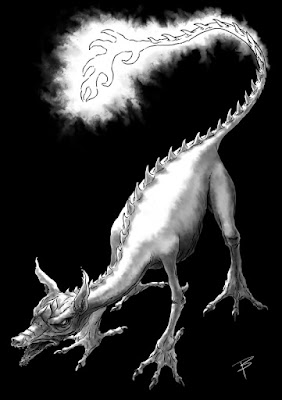BEETLE STAG
FREQUENCY: Uncommon
NO. APPEARING: 4-16
ARMOR CLASS: 4
MOVE: 18"
HIT DICE: 2
% IN LAIR: 0%
TREASURE TYPE: Nil
NO. OF ATTACKS: 4
DAMAGE/ATTACK: 1-10, 1-6, 1-6, 1-3
SPECIAL ATTACKS: Nil
SPECIAL DEFENSES: See below
MAGIC RESISTANCE: Standard
INTELLIGENCE: Non-
ALIGNMENT: Neutral
SIZE: M (4' tall, excluding antlers)
PSIONIC ABILITY: Nil
Attack/Defense Modes: Nil
Beetle
Stags are insectoid creatures somewhat similar in outline to small
stags, with both male, female and young sharing this resemblance. They
prefer to live in woodland but will sometimes stray into cultivated
areas, especially orchards and groves, and thus are considered to be
pests. The fact that they are generally not fearful and aggressively
defend themselves means that they can prove to be a quite capable
opponent. Although their eyesight is not particularly acute, their feet
and antlers are very capable of detecting movement at a distance. They
are greatly fearful of large fires and will immediately flee from any
they encounter.
Despite
their diet of wood, bark, plants, fruits and nuts they are not averse
to consuming flesh if the situation presents itself. Usually this means
that they will eat carrion but they will also readily attack dwarves,
gnomes or halflings if they outnumber their quarry. In combat, they can
strike out with their forelimbs or their antlers for 1-6 points of
damage. Their large pincers inflict 1-10 points of damage and if the
creature inflicts more than 5 damage in a single attack when using them,
its victim will be trapped in their grip unless they make a successful
roll below their Strength in order to break free. Otherwise, the
creatures extendable mouth parts will inflict 1-3 points of damage per
round (no attack roll required) until its target dies or escapes. The
long thin spines that cover the front of the Beetle Stag can cause
irritation to any exposed skin that comes into contact with them. This
will cause painful sores that inflict 1 point of damage per day unless a
successful saving throw vs poison is made. A Cure Light Wounds spell will also negate their effect.
Should
more than 12 Beetle Stags be met in a single encounter, one individual
creature will be larger than the others (6' tall, excluding antlers) and
have 3 hit dice. Aside from its normal attacks it also possesses the
ability to fire an electrical charge from its antlers, striking as a Lightning Bolt cast by a 3rd level Magic User. However, this can only be used every other round.
If
14 or more creatures are encountered, there is a 20% chance that one
individual is a Golden Beetle Stag. Its antlers are highly prized in the
construction of magical composite bows and each branch is worth 2000
gold pieces.
Beetle
Stags do not have a larval form but are born as eggs from which small
fully-formed young emerge when hatched, although in this state they
possess only one hit point.
Description:
Beetle Stags are usually iridescent shades of dark blue, green or
purple. Their antlers, pincers and feet are amber red whilst their
hair-like spines are orange-brown. Golden Beetle Stags are a rich
pearlescent golden yellow in colour, although their antlers are pale
blue.







